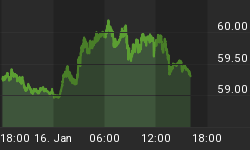The New York Fed updated its GDP Nowcast forecast for 4th quarter 2016 and 1st quarter 2017 last Friday.
Normally I report on such events, on the day of the release, but I failed to do so with all the brouhaha associated with Trump's inauguration.
Looking now, an item in the Nowcast caught my eye, leading to the title of this article. What caught my eye is weather-related.
January 20, 2017: Nowcast Highlights
- The FRBNY Staff Nowcast stands at 2.1% for 2016:Q4 and at 2.7% for 2017:Q1.
- This week's news had positive impact, moving the 2016:Q4 nowcast up by 0.2 percentage point and the 2017:Q1 nowcast up by 0.6 percentage point.
- The largest positive surprise came from industrial production and capacity utilization data.
Detail shows the 4th quarter 2016 Nowcast rose from 1.94 to 2.08. Industrial production added 0.077 percentage points to the estimate. Capacity utilization added another 0.074 percentage points. Together they accounted for 0.151 percentage points of the total rise of 0.14 percentage points (more than all of it). I have no problems with that calculation.
Nowcast 2017 1st Quarter

OK, so what's wrong with that?
The title of an article I wrote on January 18 explains: Industrial Production Jumps Due to Weather: Good News Stops There.
"A weather-boosted 6.6 percent surge in utility output fed an outsized 0.8 percent gain in industrial production for December," stated Bloomberg Econoday.
On December 18, 2016, Watts Up With That? reported U.S average temperature 16°F - colder than any time last winter, and winter hasn't started yet!
January is another matter. Temperatures have been warmer than normal for most of January. Temperatures in Chicago hit a remarkable 60 degrees last Saturday.
January Chicago Temperatures - Actual Highs vs. Average Highs

I calculate a net value of +132. That's an above average performance of +4.26 degrees per day. It would have been much greater except for a nasty five-day stretch from January 4th through January 8th.
December Chicago Temperatures - Actual Highs vs. Average Highs

For Chicago I calculate a net of -67 degrees for the month of December. That's an average of only -2.16 degrees per day.
The weather warmed up substantially at the end of the month.
Temperatures from Accuweather.
Unthinking Formulas
The problem with unthinking formulas is they extrapolate going forward. December capacity utilization affected projections for the entire quarter going forward.
If we attribute at least some of the capacity utilization increase in December to unseasonably cold weather, then that portion and more will be taken back in January.
Other data can impact the results as well, but all things being equal, the New York Fed capacity utilization projection for 1st quarter GDP will be unwound.
















